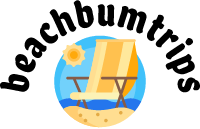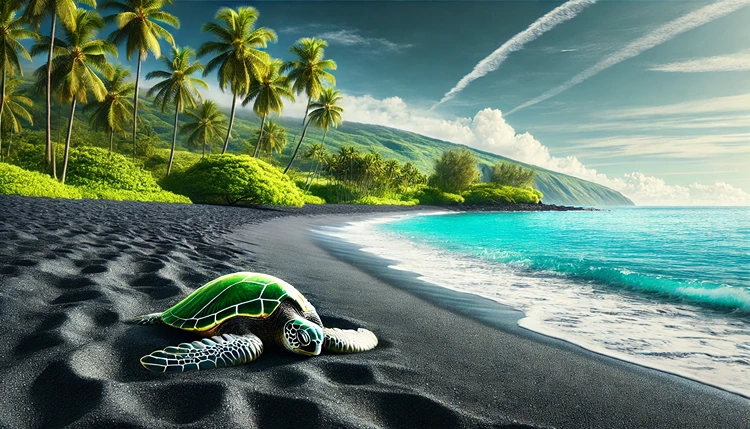Hawaii is home to some of the world’s most unique beaches, and while white sandy shores get most of the attention, the black sand beaches in Hawaii offer something truly special for nature lovers. Formed by volcanic activity over millennia, these dark, dramatic landscapes are not just a stunning visual contrast to the typical beach scene, but also havens for rare wildlife, lush greenery, and opportunities to experience Hawaii’s geological wonders up close. If you’re looking for a one-of-a-kind beach experience that goes beyond the ordinary, exploring Hawaii’s black sand beaches is a must.
What Makes Hawaii’s Black Sand Beaches Unique?
Unlike the more common golden or white sand beaches, black sand beaches in Hawaii are created from volcanic lava that has cooled and fragmented into tiny particles. This geological phenomenon makes these beaches rare and often more isolated than their traditional counterparts. Nature lovers are drawn to these beaches not only for their beauty but also for the opportunity to witness the raw power of nature at work. The contrast of the black sand against the turquoise waters and vibrant green foliage offers an experience unlike any other beach visit. But there’s more to these beaches than just aesthetics.
Helpful Hint:
While black sand beaches are mesmerizing, keep in mind that the sand can become very hot in the sun. Be sure to bring appropriate footwear to avoid discomfort while exploring the shore.
Which Are the Best Black Sand Beaches in Hawaii?
Hawaii has several black sand beaches scattered across its islands, but not all are created equal. Some stand out for their dramatic beauty, while others are celebrated for the rare wildlife they attract. Whether you’re after a peaceful retreat or a destination that offers adventure and exploration, these black sand beaches won’t disappoint.
1. Punalu’u Black Sand Beach
Punalu’u is probably the most famous black sand beach in Hawaii, and for good reason. Located on the Big Island’s southern coast, this beach is known for its striking black sand, tall coconut trees, and frequent visits from endangered green sea turtles. These majestic creatures often bask on the warm sand, offering visitors a rare chance to observe them up close in their natural habitat. Swimming and snorkeling are popular here, although the water can be a bit cool due to the freshwater springs that feed into the bay.
Stats:
According to the U.S. Fish and Wildlife Service, Hawaii is home to approximately 20,000 green sea turtles, many of which can be found basking on the state’s black sand beaches.
Unique Features of Hawaii’s Black Sand Beaches
| Beach Name | Wildlife to See | Best Time to Visit | Swimming Conditions | Special Features |
|---|---|---|---|---|
| Punalu’u Beach | Green Sea Turtles | Early Morning or Late Afternoon | Safe for Swimming | Cool Freshwater Springs |
| Waianapanapa Beach | Native Hawaiian Birds | Summer Months | Moderate Currents | Sea Caves and Lava Tubes |
| Kaimu Beach | Restoring Vegetation | Year-Round | Not Recommended | Rebirth of the Beach After Lava Flow |
| Kehena Beach | Dolphins | Morning | Strong Currents | Clothing-Optional Beach |
| Pololu Valley Beach | Native Plants | Anytime (Preferably Not Midday) | Not Safe for Swimming | Secluded Location, Hiking Required |
2. Waianapanapa Black Sand Beach
Located on the famous Road to Hana in Maui, Waianapanapa Black Sand Beach is a showstopper. The jet-black sand contrasts beautifully with the lush greenery and crystal-clear waters. This beach is part of Waianapanapa State Park, a 122-acre area filled with hiking trails, sea caves, and stunning coastal views. It’s an ideal spot for both relaxation and adventure, allowing visitors to experience Hawaii’s natural beauty in one of its most pristine forms. Be sure to check out the freshwater caves and lava tubes nearby.
3. Kaimu Beach
Kaimu Beach, also located on the Big Island, has a fascinating history. Once a popular black sand beach, it was completely covered by lava during an eruption in 1990. What makes this site special is that the beach is slowly being reborn. Locals have replanted trees and plants, and the area has developed new black sand formed by recent volcanic activity. It’s a remarkable place to witness nature’s resilience and the ongoing effects of Hawaii’s volcanic activity.
Are Black Sand Beaches Safe for Swimming?
One of the most common questions visitors ask is whether it’s safe to swim at black sand beaches. The answer varies depending on the beach. Some black sand beaches, like Punalu’u, are perfectly safe for swimming and even snorkeling. However, others, particularly those on the Big Island, can have strong currents or sharp lava rocks beneath the water’s surface, making swimming more dangerous. Always be cautious and pay attention to local warnings before taking a dip.
Helpful Hint:
Many black sand beaches in Hawaii have strong ocean currents or rocky sea floors. Before heading out for a swim, check local conditions and speak to lifeguards if available to ensure your safety.
Wildlife You Can Spot on Hawaii’s Black Sand Beaches
One of the most magical aspects of visiting Hawaii’s black sand beaches is the wildlife you may encounter. Sea turtles are a common sight, especially at beaches like Punalu’u. These endangered creatures are protected by law, so it’s important to keep your distance and avoid disturbing them. In addition to sea turtles, you may also spot native Hawaiian birds, such as the nēnē goose, and even monk seals at some of the more remote beaches. These experiences make a visit to Hawaii’s black sand beaches a true nature lover’s dream.
4. Pololu Valley Beach
Pololu Valley Beach, situated at the end of the Pololu Valley lookout on the Big Island, is a more secluded and rugged black sand beach. Unlike some of the more popular beaches, Pololu Valley offers a peaceful escape for nature lovers. To reach this hidden gem, you’ll need to hike down a steep trail, which takes around 20-30 minutes, but the effort is well worth it. The valley itself is lush and green, providing stunning views and a sense of isolation. While swimming isn’t recommended due to strong currents, the breathtaking scenery and tranquility make it a must-visit for those seeking a more off-the-beaten-path experience.
Helpful Hint:
If you’re planning to visit Pololu Valley Beach, wear sturdy hiking shoes for the steep trail descent. Bring plenty of water and snacks as there are no facilities near the beach, and make sure to pack out whatever you bring in to preserve the natural beauty of the area.
5. Kehena Black Sand Beach
Kehena Beach, located on the southeastern coast of the Big Island, is one of Hawaii’s lesser-known black sand beaches. This beach is unique not only for its dark sand but also because it’s clothing-optional, making it a popular spot for free spirits. The beach is backed by high cliffs, and the sand is a deep black due to the volcanic activity in the area. Swimming here can be risky due to strong currents, but the atmosphere is welcoming and peaceful, making it a great place for nature lovers to relax and enjoy the natural surroundings. Dolphins are often spotted in the waters offshore, adding to the beach’s charm.
What’s the Best Time to Visit Hawaii’s Black Sand Beaches?
The beauty of Hawaii is that you can visit its black sand beaches year-round, but there are some considerations that may enhance your experience. The winter months (November to March) can bring rougher surf and cooler weather, while summer (June to August) offers calmer waters and warmer temperatures, making it ideal for swimming and snorkeling. Early mornings and late afternoons are the best times to visit to avoid the midday heat, especially since black sand can get very hot under the sun.
Stats:
Hawaii’s average temperature remains between 75°F and 85°F year-round, but the summer months offer the warmest water temperatures, making them perfect for swimming at the island’s beaches.
Can You Take Black Sand as a Souvenir?
As tempting as it may be to bring home a small sample of Hawaii’s iconic black sand, it’s important to know that taking sand, rocks, or any natural material from Hawaii’s beaches is illegal. Hawaiian culture deeply values the land and natural resources, and removing anything from the islands is considered a disruption to the environment. Besides, many locals believe that taking black sand brings bad luck, and visitors have been known to return sand by mail after experiencing unfortunate events post-trip. It’s best to leave the beauty of Hawaii’s black sand beaches untouched for future visitors to enjoy.
How to Get to Hawaii’s Black Sand Beaches
Most of Hawaii’s black sand beaches are located on the Big Island, with a few on Maui. To reach these beaches, renting a car is highly recommended, especially for those that are located in more remote areas. Public transportation options are limited, and many of these beaches require a bit of a hike or drive through rural areas. Make sure to bring plenty of water, sunscreen, and any other necessities, as facilities at some of these beaches are minimal or nonexistent.
Are There Any Eco-Friendly Ways to Enjoy Hawaii’s Black Sand Beaches?
When visiting Hawaii’s black sand beaches, it’s essential to be mindful of the environment. These beaches are often in remote, pristine areas, and preserving their beauty is crucial. Here are some eco-friendly tips:
- Bring reusable water bottles and snacks to avoid single-use plastics.
- Always pack out what you bring in, leaving no trash behind.
- Stay on designated trails to prevent damaging fragile ecosystems.
- Avoid disturbing wildlife, especially endangered species like sea turtles.
By following these simple guidelines, you can enjoy your visit while ensuring that Hawaii’s black sand beaches remain unspoiled for future generations.
Pros and Cons of Visiting Hawaii’s Black Sand Beaches
Pros
- Unique and stunning landscapes, unlike traditional beaches.
- Opportunities to see rare wildlife like green sea turtles and monk seals.
- Less crowded compared to the more popular white sand beaches.
- Great for nature lovers looking to experience Hawaii’s volcanic geology up close.
- Perfect spots for photography due to the contrast between black sand and turquoise waters.
Cons
- Some beaches have strong currents, making swimming dangerous.
- Black sand can become extremely hot, requiring footwear even on the beach.
- Limited amenities and facilities at many black sand beaches.
- Remote locations can make accessibility challenging, especially for those with mobility issues.
- Taking black sand as a souvenir is illegal and frowned upon in Hawaiian culture.
FAQs
Wrapping Up
Hawaii’s black sand beaches offer a truly unique experience for nature lovers. From the volcanic origins of the sand to the rare wildlife that frequents these shores, these beaches provide a stunning alternative to Hawaii’s more typical white sand beaches. Whether you’re seeking tranquility, adventure, or a deeper connection to nature, the black sand beaches of Hawaii offer something for everyone. By visiting responsibly, following eco-friendly practices, and appreciating the fragile ecosystems these beaches support, you can ensure that these natural wonders remain preserved for future generations to enjoy.
Next time you’re planning a Hawaiian getaway, make sure to add one of these extraordinary black sand beaches to your itinerary—you won’t be disappointed.









